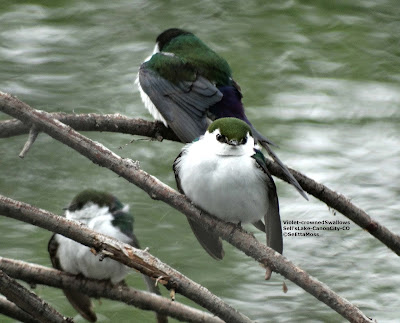Ks trip--interesting Cheyenne Bottoms hawk
 I just returned to Colo from a trip to Kansas to see an old friend, and do some birding and exploring. I also attended the fall Kansas Ornithological Society meeting. Three days ago I photographed this Red-tailed Hawk at Cheyenne Bottoms, a great migration stop-over that has been designated a Wetland of International Importance and is the largest marsh in the interior U.S. This hawk was quite wary making it most difficult to get any good photos and all my pics were taken from a distance.This hawk has a lot of white on it's head; Underparts- a white belly without rufous or buff; Upperparts- scapulars mottled with white, white mottled upperwing panels, more white mottling on upperwing coverts; tail-white uppertail coverts with some dark marks, banding that is darkest at the tips of the rectices; Wings-dark patagial marks. These characteristics are all consistent with those of juvenile light morph Harlan's (B. j. harlani) Red-tailed Hawk.
I just returned to Colo from a trip to Kansas to see an old friend, and do some birding and exploring. I also attended the fall Kansas Ornithological Society meeting. Three days ago I photographed this Red-tailed Hawk at Cheyenne Bottoms, a great migration stop-over that has been designated a Wetland of International Importance and is the largest marsh in the interior U.S. This hawk was quite wary making it most difficult to get any good photos and all my pics were taken from a distance.This hawk has a lot of white on it's head; Underparts- a white belly without rufous or buff; Upperparts- scapulars mottled with white, white mottled upperwing panels, more white mottling on upperwing coverts; tail-white uppertail coverts with some dark marks, banding that is darkest at the tips of the rectices; Wings-dark patagial marks. These characteristics are all consistent with those of juvenile light morph Harlan's (B. j. harlani) Red-tailed Hawk. What is not consistent is the dark belly marks (juv light morph Harlan's have streaking per Raptors of Western North America, p. 330, by Brian Wheeler (Jerry Liguori in Hawks from Every Angle says that light morph Harlan's have "broad, distinct streaks on the belly" p. 54).
 There is the possibility of an intergrade that might also fit this hawk. Wheeler notes that juvenile Harlan's migrate a little before adults and that some adults are on their wintering grounds, which includes Kansas, by early October so it would seem the timing for this bird would also be consistent with a Harlan's hawk. That said, given all the various races and variations, I will ask for some assistance in determining if this hawk is a juvenile light morph Harlan's or not. SeEtta
There is the possibility of an intergrade that might also fit this hawk. Wheeler notes that juvenile Harlan's migrate a little before adults and that some adults are on their wintering grounds, which includes Kansas, by early October so it would seem the timing for this bird would also be consistent with a Harlan's hawk. That said, given all the various races and variations, I will ask for some assistance in determining if this hawk is a juvenile light morph Harlan's or not. SeEtta


Comments